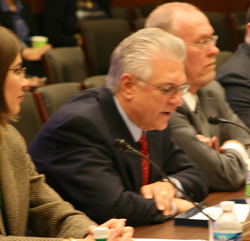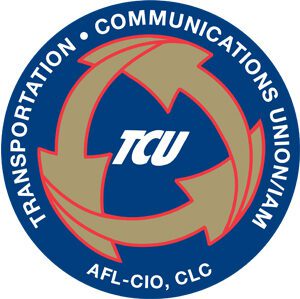
The merits and challenges of High Speed Rail in the United States were discussed in front of the Committee on Transportation and Infrastructure’s Subcommittee on Railroads, Pipelines and Hazardous Materials. The Committee met for a lengthy time and at times the gallery was standing room only, clearly showing how important this topic is.
TCU International President Bob Scardelletti was invited to testify before the Committee. His message was loud and clear, “Amtrak and its workforce must be fully utilized as the backbone of high speed rail in America.” He went on to say, “Amtrak has a dedicated and experienced workforce of ticket agents, baggage handlers, Carmen, on-board service workers, supervisors, machinists, sheet metal workers, electricians, boilermakers, signalmen, train dispatchers, maintenance of way workers, firemen and oilers, engineers and conductors who are all vital to run a passenger rail system.”
Bob Scardelletti spoke about the major legislation that affects High Speed Rail both already passed and in progress, “The most significant challenge is to ensure that these initiatives are implemented correctly. It is imperative that the FRA vigorously enforces the statutory requirements attached to high speed rail funding particularly those designed to protect the jobs and rights of workers.”
FRA Administrator Joe Szabo echoed those statements, “…if you touch this money you must know that you get us as well.” Specifically mentioning Railroad Retirement and Railway Labor laws he made it clear that any grant money received must meet those guidelines.
Listed below is the major legislation that affects High Speed Rail both already passed and in progress:
The Passenger Rail Investment and Improvement Act (PRIIA) was passed on October 16, 2008. PRIIA authorized a total of $13.06 billion over five years to support Amtrak’s ongoing capital and operating needs, help bring the Northeast Corridor to a state-of-good-repair, and encourage the development of new and improved intercity passenger rail service through an 80-20 Federal/State matching grant programs.
American Recovery and Reinvestment Act of 2009 was signed on February 17, 2009. The Recovery Act provides $64.1 billion of infrastructure investment, of which $9.3 billion is dedicated for passenger rail. This includes $8 billion in grants to States for development of intercity passenger and high-speed rail, in accordance with sections 301 and 501 of PRIIA. Funds are available through September 30, 2012. The remaining $1.3 billion was provided to Amtrak for capital and safety/security improvements. Those funds are available through September 30, 2010.
The Surface Transportation Authorization Act (STAA), a bill that will reauthorize the Federal highway, transit, and highway safety programs for the next six years, provides $50 billion to develop the 11 authorized high-speed rail corridors linking major metropolitan regions throughout the United States. The STAA will create a long-term investment program for developing high-speed rail nationwide. Greater consideration will be given to projects that encourage intermodal connectivity; create new jobs; promote energy efficiency, environmental, and other public benefits; and leverage contributions from state and private sources. In addition, FRA will conduct an evaluation of the proposals’ impact on the preservation or expansion of domestic manufacturing capabilities as well as new or expanded business opportunities in the United States.
The STAA will also make high-speed rail development projects eligible for financing through the National Infrastructure Bank, and create a research, development, and demonstration program for high-speed rail technologies. This new program will generate opportunities to create jobs by establishing high-speed rail locomotive and car manufacturing facilities in the United States. The STAA will provide funding for high-speed rail corridor planning activities, including environmental work.
The Witnesses testifying before the committee include:
Robert Baugh, Executive Director of the Industrial Union Council AFL-CIO
Frank Busalacchi, States for Passenger Rail Coalition
Thomas Carper, Chairman of the Board National Railroad Passenger Corporation (Amtrak)
Susan Fleming, Director Government Accountability Office
Ed Hamberger, President Association of American Railroads
Michael P. Pracht, President & CEO US Railcar, LLC
Nicolas Rubio, President Cintra US
Robert Scardelletti, President Transportation Communications International Union
Patrick Simmons, Rail Division Director North Carolina Department of Transportation
Joseph C. Szabo, Administrator Federal Railroad Administration
Petra Todorovich, Director America 2050
Click here to view the entire testimony of Bob Scardelletti before the Committee.
Click here to view the invitation to Bob Scardelletti to testify before the Committee.
Click here to view the Committee overview and expected subject matter.
Click here to go to the TCU High Speed Rail webpage.

